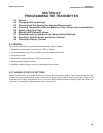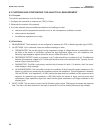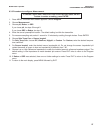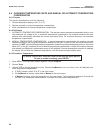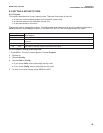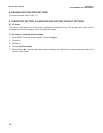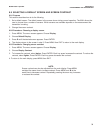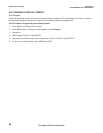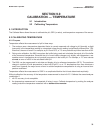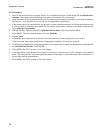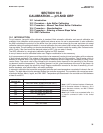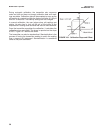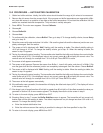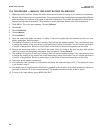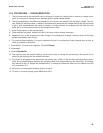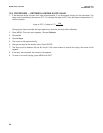
33
MODEL 6081-P pH/ORP SECTION 9.0
CALIBRATION – TEMPERTURE
SECTION 9.0
CALIBRATION — TEMPERATURE
9.1 INTRODUCTION
The Calibrate Menu allows the user to calibrate the pH, ORP (or redox), and temperature response of the sensor.
9.2 CALIBRATING TEMPERATURE
9.2.1 Purpose
Temperature affects the measurement of pH in three ways.
1. The analyzer uses a temperature dependent factor to convert measured cell voltage to pH. Normally, a slight
inaccuracy in the temperature reading is unimportant unless the pH reading is significantly different from 7.00.
Even then, the error is small. For example, at pH 12 and 25°C, a 1°C error produces a pH error less than ±0.02.
2. During auto calibration, the 6081 recognizes the buffer being used and calculates the actual pH of the buffer
at the measured temperature. Because the pH of most buffers changes only slightly with temperature, rea-
sonable errors in temperature do not produce large errors in the buffer pH. For example, a 1°C error causes
at most an error of ±0.03 in the calculated buffer pH.
3. The 6081 can be programmed to calculate and display pH at a reference temperature (25°C). The maximum
change in solution pH with temperature is about ±0.04 pH/°C, so a 1°C temperature error does introduce a
small error. However, the major source of error in solution temperature compensation is using an incorrect tem-
perature coefficient.
Temperature affects the measurement of ORP in a complicated fashion that is best determined empirically.
Without calibration the accuracy of the temperature measurement is about ±0.4°C. Calibrate the sensor/analyzer
combination if
1. ±0.4°C accuracy is not acceptable
2. the temperature measurement is suspected of being in error. Calibrate temperature by making the analyzer
reading match the temperature measured with a standard thermometer.
9.1 Introduction
9.2 Calibrating Temperature



